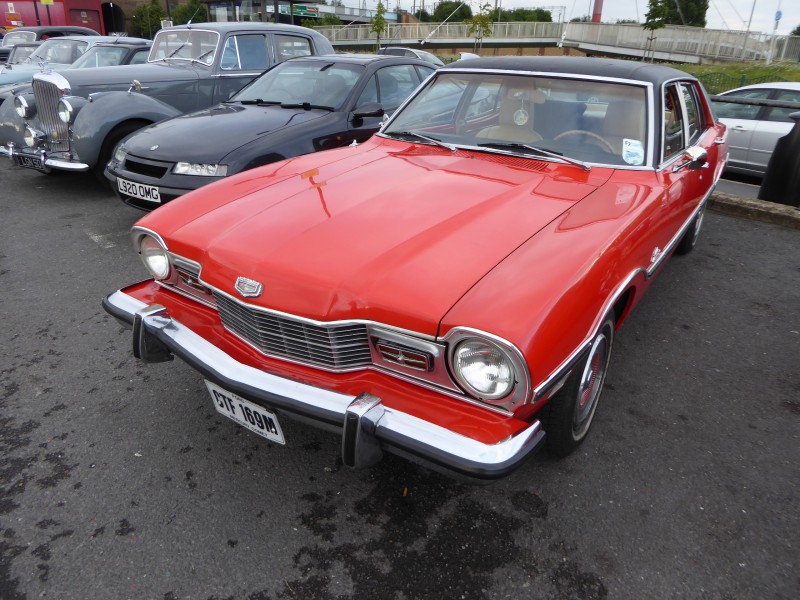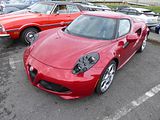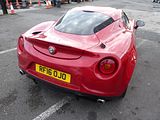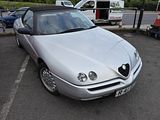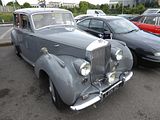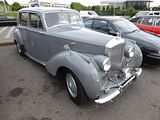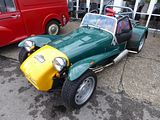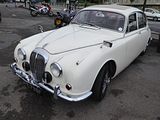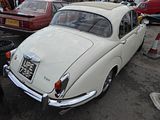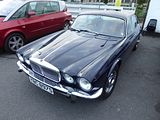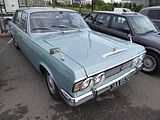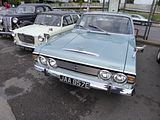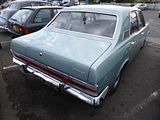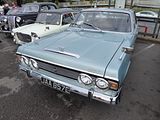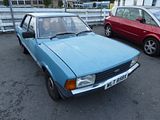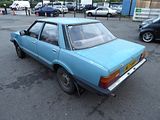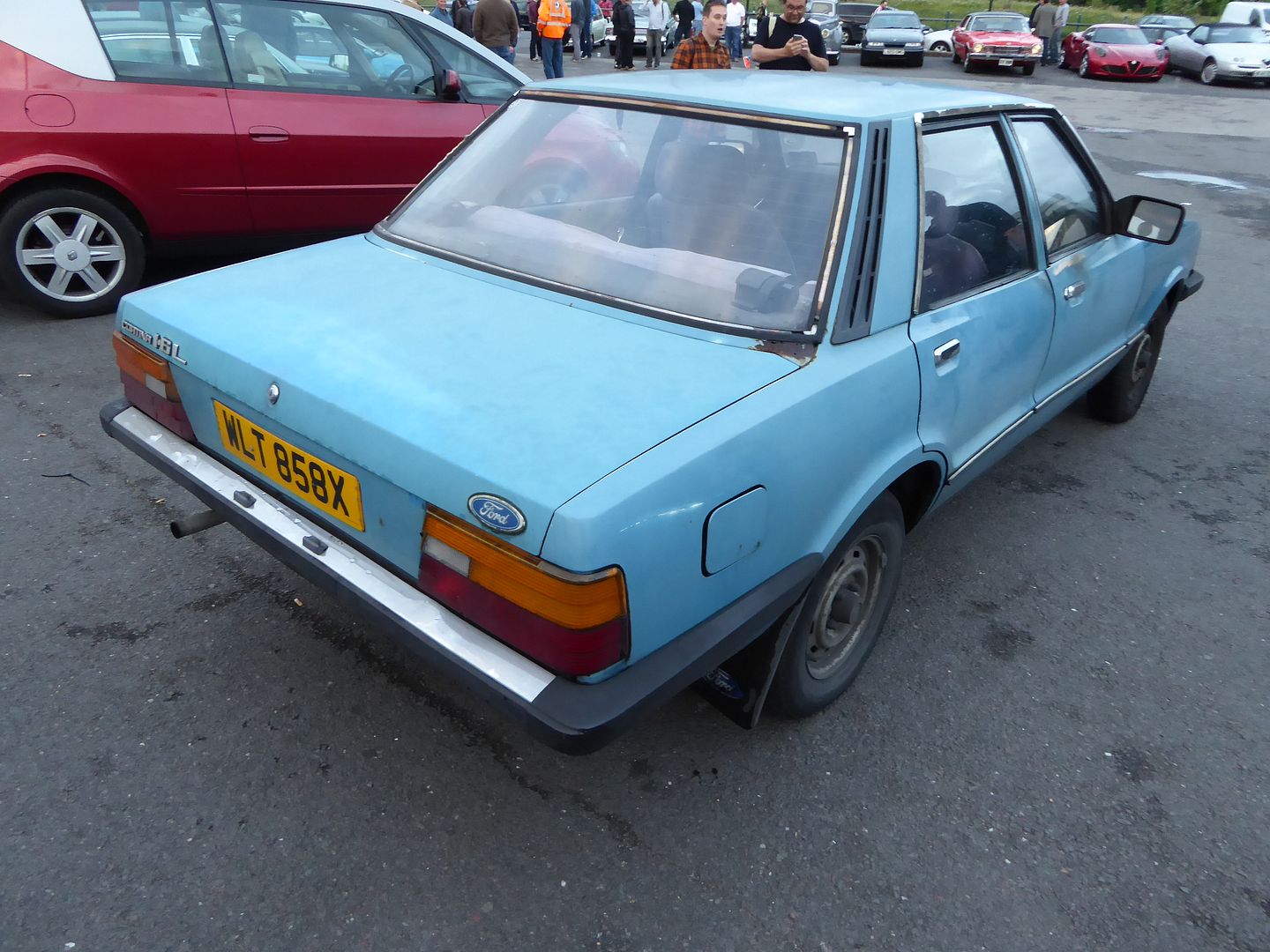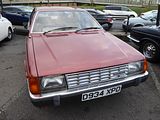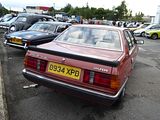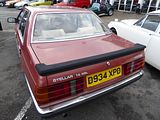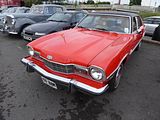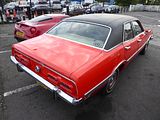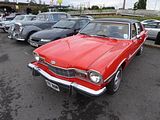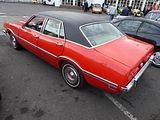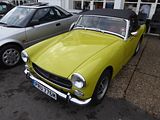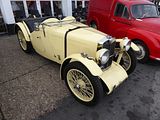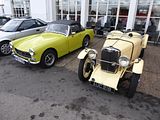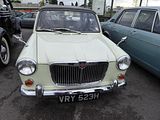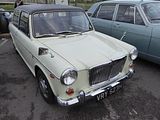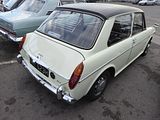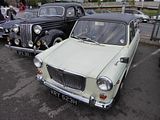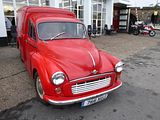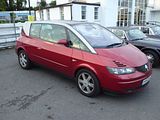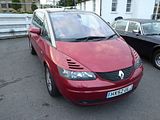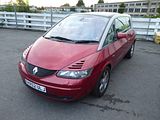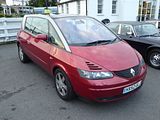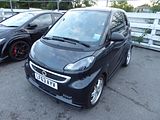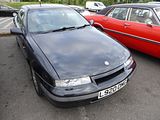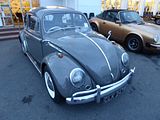Of all the themed evenings that take place as part of a monthly cycle at the legendary Ace Cafe, the “Classics” gathering on the second Tuesday of the month that is most likely to produce the most diverse assembly of cars, and also to hold an interest for me second perhaps only to the Italian Nights which take place either a couple of days later, or five days earlier, depending on what day of the week holds the calendar date of the First of the Month. Having said that, I’ve not done a very good job at attending Classics Night, the July one reported on here being the fist such in 2016. With summer weather having been in something of a short supply during the long evenings of daylight, I suspect that others have also not been attending in the numbers that you might have seen in previous years, as when I arrived, mid-evening, following an early activity on the squash court, I found a forecourt that was far from fully occupied, with only a handful of cars parked up. However, more did arrived during the evening, but at no time was even the perimeter completely occupied, let alone cars needing to park out on the street, as has sometime been the case. The relative lack of quantity was more than made up for by the diversity of what was present, though, as this report evidences.
ALFA ROMEO
First Alfa to arrive, a few minutes after I had reached the Cafe was this 4C Competizione, Alfa’s stunning looking mid-engined sports car. First seen as a concept at the 2011 Geneva Show, it was another 2 years before production got underway at the Maserati plant in Modena, with the first deliveries being made late in 2013. Production was originally pegged at 1000 cars a year and a total of just 3500, which encouraged many speculators to put their name down in the hope of making a sizeable profit on selling their cars on. That plan backfired, and in the early months, there were lots of cars for sale for greater than list price. Press reaction to the car has been mixed, with everyone loving the looks, but most of them feeling that the driving experience is not as they would want. Owners generally disagree – as is so often the case! – and most love their car. I know I would if I could find space (and funds!) for one in my garage!
It was not long before another Alfa Romeo arrived, this one being a 916 Series Spider. The 916 Series cars were conceived to replace two very different models in the Alfa range. First of these was the open topped 105 Series Spider which had been in production since 1966 and by the 1990s was long overdue a replacement. Alfa decided to combine a follow on to the Alfetta GTV, long out of production, with a new Spider model, and first work started in the late 1980s. The task was handed to Pininfarina, and Enrico Fumia’s initial renderings were produced in September 1987, with the first clay models to complete 1:1 scale model made in July 1988. Fumia produced something rather special. Clearly an Italian design, with the Alfa Romeo grille with dual round headlights, recalling the Audi-based Pininfarina Quartz, another design produced by Enrico Fumia back in 1981, the proposal was for a car that was low-slung, wedge-shaped with a low nose and high kicked up tail. The back of the car is “cut-off” with a “Kamm tail” giving improved aerodynamics. The Spider would share these traits with the GTV except that the rear is rounded, and would feature a folding soft-top with five hoop frame, which would completely disappear from sight under a flush fitting cover. An electric folding mechanism would be fitted as an option. Details included a one-piece rear lamp/foglamp/indicator strip across the rear of the body, the minor instruments in the centre console angled towards the driver. The exterior design was finished in July 1988. After Vittorio Ghidella, Fiat’s CEO, accepted the design, Alfa Romeo Centro Stile under Walter de Silva was made responsible for the completion of the detail work and also for the design of the interiors, as Pininfarina’s proposal was not accepted. The Spider and GTV were to be based on the then-current Fiat Group platform, called Tipo Due, in this case a heavily modified version with an all new multilink rear suspension. The front suspension and drivetrain was based on the 1992 Alfa Romeo 155 saloon. Chief engineer at that time was Bruno Cena. Drag coefficient was 0.33 for the GTV and 0.38 for the Spider. Production began in late 1993 with four cars, all 3.0 V6 Spiders, assembled at the Alfa Romeo Arese Plant in Milan. In early 1994 the first GTV was produced, with 2.0 Twin Spark engine. The first premiere was then held at the Paris Motor Show in 1994. The GTV and Spider were officially launched at the Geneva Motor Show in March 1995 and sales began the same year. The cars were well received. At launch, many journalists commented that Alfa had improved overall build quality considerably and that it came very close to equalling its German rivals. I can vouch for that, as I owned an early GTV for eighteen months, and it was a well built and reliable car. In 1997 a new engine, a 24-valve 3.0 litre V6, was available for the GTV along with bigger, 12.0 inch brakes and red four-pot calipers from Brembo. The console knobs were changed from round central to rectangle ones and to a three-spoke steering wheel. Some versions were upgraded with different front bumper mesh to bring the wind noise down to 74 dBA. In May 1998 the cars were revamped for the first time, creating the Phase 2 models. Most of the alterations were inside. The interior was changed with new centre console, painted letters on skirt seals, changed controls and switches arrangement and different instrument cluster. Outside, the main changes included chrome frame around the grille and colour-coded side skirts and bumpers. A new engine was introduced, the 142 hp 1.8 Twin Spark, and others were changed: the 2.0 Twin Spark was updated with a modular intake manifold with different length intakes and a different plastic cover. Power output of the 2.0 TS was raised to 153 hp. Engines changed engine management units and have a nomenclature of CF2. The dashboard was available in two new colours in addition to the standard black: Red Style and Blue Style, and with it new colour-coded upholstery and carpets. The 3.0 24V got a six-speed manual gearbox as standard and the 2.0 V6 TB engine was now also available for the Spider. August 2000 saw the revamp of engines to comply with new emission regulations, Euro3. The new engines were slightly detuned, and have a new identification code: CF3. 3.0 V6 12V was discontinued for the Spider and replaced with 24V Euro3 version from the GTV. 2.0 V6 Turbo and 1.8 T.Spark were discontinued as they did not comply with Euro3 emissions. By the 2001-2002 model year, only 2 engines were left, the 2.0 Twin.Spark and 3.0 V6 24V, until the Phase 3 engine range arrived. The Arese plant, where the cars had been built, was closing and, in October 2000, the production of GTV/Spider was transferred to Pininfarina Plant in San Giorgio Canavese in Turin. In 2003 there was another and final revamp, creating the Phase 3, also designed in Pininfarina but not by Enrico Fumia. The main changes were focused on the front with new 147-style grille and different front bumpers with offset numberplate holder. Change to the interior was minimal with different centre console and upholstery pattern and colours available. Instrument illumination colour was changed from green to red. Main specification change is an ASR traction control, not available for 2.0 TS Base model. New engines were introduced: 163 hp 2.0 JTS with direct petrol injection and 237 hp 3.2 V6 24V allowing a 158 mph top speed. Production ceased in late 2004, though some cars were still available for purchase till 2006. A total of 80,747 cars were made, and sales of the GTV and Spider were roughly equal. More V6 engined GTVs than Spiders were made, but in 2.0 guise, it was the other way round with the open model proving marginally more popular.
BENTLEY
One of the grander cars of the evening was this R Type Bentley, the second series of post-war Bentley automobiles, replacing the Mark VI. Essentially larger-boot version of the Mk VI, the R type is regarded by some as a stop-gap before the introduction of the S series cars in 1955. As with its predecessor, a standard body was available as well as coachbuilt versions by firms including H. J. Mulliner & Co., Park Ward, Harold Radford, Freestone and Webb and others. During development it was referred to as the Bentley Mark VII; the chassis cards for these cars describe them as Bentley 7. The R Type name which is now usually applied stems from chassis series RT. The front of the saloon model was identical to the Mark VI, but the boot was almost doubled in capacity. The engine displacement was approximately 4½ litres, as fitted to later versions of the Mark VI. An automatic choke was fitted to the R-type’s carburettor. The attachment of the rear springs to the chassis was altered in detail between the Mark VI and the R Type. For buyers looking for a more distinctive car, a decreasing number had custom coachwork available from the dwindling number of UK coachbuilders. These ranged from the grand flowing lines of Freestone and Webb’s conservative, almost prewar shapes, to the practical conversions of Harold Radford which including a clamshell style tailgate and folding rear seats. All R Type models use an iron-block/aluminium-head straight-6 engine fed by twin SU Type H6 carburettors. The basic engine displaced 4,566 cc with a 92 mm bore and 114.3 mm stroke. A 4-speed manual transmission was standard with a 4-speed automatic option becoming standard on later cars. The suspension was independent at the front using coil springs with semi elliptic leaf springs at the rear. The brakes used 12.25 in drums all round and were operated hydraulically at the front and mechanically at the rear via a gearbox driven servo. Other than the radiator grilles and the carburation there was little difference between the standard Bentley R Type and the Rolls-Royce Silver Dawn. The R Type was the more popular marque, with some 2,500 units manufactured during its run to the Silver Dawn’s 760. The survival rate is not that great, as the bodies had a habit of rusting.
CATERHAM
Although painted up in the style of the “Prisoner” style Lotus Seven, this was a more recent build, and hence was a Caterham car.
DAIMLER
Slightly surprisingly, perhaps, Daimler was one of the best represented marques, with three examples of these cars present, easily identified by the fluted top to their radiator grilles. Oldest of the trio was a V8-250. This car used the 2½ litre V8 engine that had first been seen in the SP250 “Dart”, but now power the smaller saloon Daimler had wanted from the start when they developed the engine. The result was basically a Jaguar Mark 2 with the V8 engine from the SP250 modified to fit in the Mark 2 engine bay and revised interior, trim, and suspension settings. Sold between 1962 and 1967 as the Daimler 2½-litre V8 and from 1967 to 1969 as the Daimler V8-250, this is the Daimler car with the highest production figures.
When the second of the Double Six models arrived on site, the owner of the later Series 2 car moved his so the two were parked next to each other. The Double Six was the Daimler version of the Jaguar XJ12, and differed outside only with its distinctive fluted grille. Launched along side the Jaguar, in 1972, this 5.3 litre V12 engined car took a name used by the company from 1926 to 1938 was revived. One reason cited for this is that previous Jaguar-Daimler chairman Sir William Lyons had just retired from Jaguar, and the new chairman, FRW (Lofty) England, had been a Daimler apprentice from 1927 to 1932 and taken second place in the first ever RAC rally driving a 30/40 hp Daimler Double-Six. So Lofty England decreed that the new V12 Daimler would be known as Double-Six. Unlike the Jaguar, the twelve-cylinder Daimler had the same radiator grille as its six-cylinder sibling, and externally only the badges distinguished them. The Double-Six followed the same changes as the Sovereign from Series I to Series III, although the Sovereign name was transferred to Jaguar, the Double-Six name remained with Daimler throughout Series III production, which continued until 1992. In late 1972, the particularly well-equipped Double-Six Vanden Plas appeared. On a 4 inches longer wheelbase, this model also received a black vinyl roof to set it apart. A two door coupé was offered in the Double-Six Series II range from 1975 to 1977, as an addition to the four door saloon. It was marketed as the Daimler Double-Six two door. Only small numbers of Damiler models were sold relative to the Jaguar, so seeing two here was quite a rarity.
FORD
Largest of the three Ford models here was a Zodiac Mark IV, one of the last of 4 generations of “Z car”. The concept for the Mark IV goes back to 1961, when Ford began a complete redesign on the Zephyr, under the title of “Project Panda”. As the car used the new V-series engines, the then traditional long bonnet concept created a problem until design engineer Harley Copp required that the car was both larger and had more internal space, and came up with the idea of placing the spare wheel ahead of the radiator on an angle. The result was a vehicle of similar dimensions to the North American Ford Fairlane. The Mk IV range was launched, not at an October motorshow, but in early 1966 with new V-format engines, the 4 having a 1,996 cc V4 and the 6 a 2,495 cc V6 unit. The independent suspension was aided by servo-assisted disc brakes on all wheels. Criticism of the handling of early examples in the UK led to the fitting as standard of radial-ply tyres on the larger-engined version in place of the more conventional (in the UK at that time) cross-ply tyres with which all versions were shod at the 1966 launch, and the retro-fitting of radial-ply tyres to early examples addressed the tendency of the rear wheels to slide uncontrollably in wet weather, justifying in the process Ford’s investment in a new and relatively sophisticated rear suspension arrangement for the Mark IVs. Even after that a contemporary nevertheless opined that the ride involved a certain amount of ‘float’, and reported that the nose-heavy handling called for a ‘strong driver’, a problem which the more expensive Zodiac and Executive versions mitigated through the fitting as a standard feature of power assisted steering. Cost constraints precluded adding power assisted steering for the Zephyr, but during its production run the steering ratio was lowered which reduced the strength needed to change direction by increasing the number of turns between locks from 5.5 to an even higher 6.4. Another production modification for the 4-cylinder Zephyr involved redesigning the valve gear in order to eliminate the need on the early Mk IVs for frequent tappet adjustments. The size of the bonnet was emphasised by square cut styling of the wings. A practical use was found for some of the extra space in front of the driver: the spare wheel was stored, ahead of the engine, under the bonnet, freeing up space at the other end of the car for more luggage. Although large, the car, at least in its Zephyr form, was not particularly luxurious. Individual front seats were available at extra cost, but the standard front bench-seat was described by one commentator who ran the car on a long-term test as being intended for people no taller than 5 ft 8 in who have the right leg 3 inches shorter than the left. An estate version of the Zephyr Mark IV was announced just in time for the London Motor Show in October 1966, though deliveries commenced only in January 1967. As with the earlier Zephyrs, volumes did not justify tooling up for estate production at the Dagenham plant, and the cars were instead built by E.D. Abbott Ltd of Farnham, based on part finished saloons received from Ford. The Mark IV Zephyr estates (like their more expensive Zodiac siblings) came with black vinyl-covered roof, a fashionable distinguishing feature of upmarket vehicles at the time: retention unchanged of the saloon’s rear light clusters attracted criticism, however, because of the way it narrowed the rear hatch opening at floor level when compared to the arrangements on the cheaper Ford Cortina estates. Many Mark IVs met their end on the banger racing circuit and they are the least common of the four generations of the Zephyr/Zodiac these days.
Precursor to the Zephy and Zodiac range of cars was the Pilot an example of which was also here. Known as the Model E71A, the Pilot was an upper-medium sized car that was built by Ford in the UK from August 1947 to 1951, at which point it was effectively replaced with the launch of Ford UK’s Zephyr Six and Consul models, though V8 Pilots were still offered for sale, being gradually withdrawn during that year. During the period of manufacture 22,155 cars were produced. The majority of Pilots were four door saloons, with a small number of Estate cars and Pickups, these last for export only.
Final Ford here was a Cortina 80 1.6L, the most popular version of the car which was Britain’s best seller throughout its life. The car was announced on 24 August 1979. Officially the programme was code named Teresa, although externally it was marketed as “Cortina 80”, but the Mark V tag was given to it immediately on release by the press, insiders and the general public. Largely an update to the Mark IV, it was really a step between a facelift and a rebody. The Mark V differentiated itself from the Mark IV by having revised headlights with larger turn indicators incorporated (which were now visible on the side too), a wider slatted grille said to be more aerodynamically efficient, a flattened roof, larger glass area, slimmer C-pillars with revised vent covers, larger slatted tail lights (on saloon models) and upgraded trim. Improvements were also made to the engine range, with slight improvements to both fuel economy and power output compared to the Mark IV. The 2.3 litre V6 engine was given electronic ignition and a slight boost in power output to 116 bhp, compared to the 108 bhp of the Mark IV. Ford also claimed improved corrosion protection on Mark V models; as a result, more Mark Vs have survived; however, corrosion was still quite a problem. The estate models combined the Mark IV’s bodyshell (which was initially from the 1970 Ford Taunus) with Mark V front body pressings. A pick-up (“bakkie”) version was also built in South Africa. These later received a longer bed and were then marketed as the P100. Variants included the Base, L, GL, and Ghia (all available in saloon and estate forms), together with Base and L spec 2-door sedan versions (this bodystyle was available up to Ghia V6 level on overseas markets). The replacement for the previous Mark IV S models was an S pack of optional extras which was available as an upgrade on most Mark V models from L trim level upwards. For the final model year of 1982 this consisted of front and rear bumper overriders, sports driving lamps, an S badge on the boot, tachometer, 4 spoke steering wheel, revised suspension settings, front gas shock absorbers,’Sports’ gear lever knob, sports road wheels, 185/70 SR x 13 tyres and Fishnet Recaro sports seats (optional). Various “special editions” were announced, including the Calypso and Carousel. The final production model was the Crusader special edition which was available as a 1.3 litre, 1.6 litre, and 2.0 litre saloons or 1.6 litre and 2.0 litre estates. The Crusader was a final run-out model in 1982, along with the newly introduced Sierra. It was the best-specified Cortina produced to date and 30,000 were sold, which also made it Ford’s best-selling special edition model. Another special edition model was the Cortina Huntsman, of which 150 were produced. By this time, the Cortina was starting to feel the competition from a rejuvenated Vauxhall, which with the 1981 release Cavalier J-Car, was starting to make inroads on the Cortina’s traditional fleet market, largely helped by the front wheel drive benefits of weight. Up to and including 1981, the Cortina was the best selling car in Britain. Even during its final production year, 1982, the Cortina was Britain’s second best selling car and most popular large family car. On the continent, the Taunus version was competing with more modern and practical designs like the Talbot Alpine, Volkswagen Passat, and Opel Ascona. The very last Cortina – a silver Crusader – rolled off the Dagenham production line on 22 July 1982 on the launch of the Sierra, though there were still a few leaving the forecourt as late as 1987, with one final unregistered Cortina GL leaving a Derbyshire dealership in 2005. The last Cortina built remains in the Ford Heritage Centre in Dagenham, Essex, not far from the factory where it was assembled. This one was gloriously unrestored, with body panels which were in subtly different shades of blue, and whilst outside had traces of rust in places, the inside was in a far more “used” state.
HYUNDAI
Probably the rarest car present was this 1986 Hyundai Stellar GSL. The Stellar as the second model that Hyundai brought to the UK, arriving in 1984, a couple of years after the brand had arrived with the smaller Pony. Like that car, the Stellar was styled by Giorgio Giugiaro. Underneath, though it was based on the chassis of the Ford Cortina 80, a model which Hyundai had been building under licence. That meant that it was a rear wheel drive car, one of the last in its segment to be lauched, as this was the era when the move to front wheel drive (approved of by the motoring press, who were not all about tail slides and track days as they are now!). The mechanical part came from Mitsubishi, with – depending on the market, a choice of 1400cc and 1600cc petrol engines and either a KM119 5-speed manual or a Borg-Warner 03-55L 3-speed automatic. A 2 litre engine was added to the range in 1987, though the UK only ever received the 1600cc cars. Trim levels included L, GL/CL, and GSL/CXL. The GSL/CXL featured power windows, locks and mirrors; remote fuel door and boot releases, a premium sound system, full instrumentation (speed, tach, fuel, water temp, volts, and oil pressure) and available air conditioning, a rather surprising list of features for the year and type of car. The Stellar was replaced in early 1989 by the first generation Sonata. The Stellar’s Ford genes and conventional design led many British observers to compare it with the then recently discontinued Cortina – where conservative buyers were scared off by the Sierra’s radical styling, a fact played upon by Hyundai’s advertising agency with print advertisements depicting a jelly mould shaped like the Sierra, above a picture of the Stellar. As well as being comparable to the Cortina, which had been Britain’s best selling car, it also found favour with buyers due to its competitive asking price, which meant that it was priced comparably to a smaller Escort rather than a Sierra. The cars were reliable and many lived on as mini cabs, finally expiring after covering huge mileages. This car – one of just 8 believed to remain in the UK, was found by its keen owner last year, with just 102,000 miles on the clock. He found that it had done only a handful of miles in the past 20 years, having been owned by an elderly driver, and apart from a few body dents, the car was in very good condition, which is just as well, as the chances of finding replacement body and trim parts are almost zero. He takes the car to events and shows around the London and South East area and said it always attracts lots of interest – not because it is a particularly good car (it is not, and he said that the 1983 Mazda 626 which he also found last year is much “better” to drive), but because it so unusual.
MERCURY
There are probably even fewer examples of this car in the UK. Indeed, it would not surprise me if this is the only one. It is a 1973 Mercury Comet. The name had first been used on Mercury’s version of the Ford Falcon in 1960, which was produced through to 1969. For 1971, the Comet name was revived on Mercury’s version of the Ford Maverick compact. Sharing most of its sheet-metal with the Maverick, it used a different grille, taillights, and hood, as well as different badging. The taillight pods were shared with the 1970 and 1971 Montego and Cyclone models. Underneath it all was the same basic chassis that had originally been used for the Ford Falcon, the original Comet, and for the mid-sized Ford Fairlane, Mercury Meteor, and later Mercury Comets. The base engine was the 170 cid inline-6 with a single-barrel carburettor producing 100 hp at 4200 rpm. Optional engines were the 200 cid inline-6 with a single-barrel carburettor producing 115 hp and a 302 cid V8 with a 2-barrel carburettor producing 210 hp. Transmissions were either a 3-speed manual or 3-speed automatic with either column or floor-mounted gearchanges. The Comet was available as 2- and 4-door sedans and in base (1971–1977), and “muscle car” Comet GT series (2-door sedan-only 1971-1975). The GT featured a blacked-out grille, dual body-side tape stripes, high-back bucket seats, wheel trim rings, dual racing mirrors, bright window frames, black instrument panel, deluxe door trim panels, and a simulated hood scoop. In 1972 models, the base 170 cid six was rated at 82 hp at 4400 rpm, the 200 cid six at 91 hp, and the 302 cid V8 at 138 hp. A new engine option for 1972 was the 250 cid six with a single-barrel carburettor rated at 98 hp. For 1973 models, the base 170 cid six was dropped and the 200 cid six became the base engine. Horsepower ratings would fluctuate slightly up or down through the years the Comet would remain in production, but not by very much. A new, larger front bumper to meet federal standards was added to all models in 1973. A new Custom decor package featuring vinyl roof, body-coloured wheel covers, wide vinyl-insert body-side mouldings, vinyl bucket seats, luxury carpeting, and extra sound insulation was a popular option. Changes for 1974 included even larger front bumpers and new larger rear bumpers to match. They added 2.5 in to the length of the 2-door model and 4 in to the length of the 4-door model. Ford had originally planned to the replace the Comet and its Ford Maverick counterpart for the 1975 model year with updated and extensively redesigned models that would continue to use the Comet and Maverick names. Fairly late, though, they decided that the updated versions would be built alongside the original Maverick and the Comet that had originally been introduced for 1971. These would-be replacements, also using the same basic chassis as the Comet and Maverick, became the Mercury Monarch and the American Ford Granada, came with more standard and optional equipment than the Comet and Maverick, and were considered to be “luxury compacts,” a step up from the Comet and Maverick. The model was offered with comparatively few changes through the 1977 model year, and was then discontinued to make room for the new Mercury Zephyr for the 1978 model year.
MG
Most familiar of the 3 MGs that were here was this 1973 Midget in the very period colour that BL called Citron. Many will tell you that this was the year of the nicest Midgets before they received the rubber 5 mph bumpers and raised ride height. MG resurrected the name that they had used for their smallest car, the M Type, in the late 20s, with the 1961 car which was essentially a slightly more expensive badge-engineered version of the MkII Austin-Healey Sprite. The original ‘Frogeye’ Sprite had been introduced specifically to fill the gap in the market left by the end of production of the MG T-type Midget as its replacement, the MGA had been a significantly larger and more expensive car with greater performance. Many existing MG enthusiast and buyers turned to the Sprite to provide a modern low-cost sports car and so a badge-engineered MG version reusing the Midget name made sense. The new Midget differed from the Sprite only in its grille design, badging, colour options and having both leather seats and more external chrome trim as standard to justify its higher purchase price. Mechanically the car was identical to its Austin-Healey counterpart, retaining the rear suspension using quarter-elliptic leaf springs and trailing arms from the ‘Frogeye’. The engine was initially a 948 cc A-Series with twin SU carburettors producing 46 hp at 5500 rpm and 53 lb/ft at 3000 rpm. Brakes were 7″ drums all round. A hard top, heater, radio and luggage rack were available as factory-fitted extras. In October 1962 the engine was increased to 1098 cc, raising the output to 56 hp at 5500 rpm and 62 lb/ft at 3250 rpm, and disc brakes replaced the drums at the front. Wire spoked wheels became available. The doors had no external handles or locks and the windows were sliding Perspex side-screens. A heater was still an optional extra. The car sold well, with 16,080 of the small-engined version and 9601 of the 1098 being made before the arrival in 1964 of the Mark II. Externally the main changes were to the doors, which gained wind-up windows, swivelling quarter lights, external handles and separate locks. The windscreen also gained a slight curvature and was retained in a more substantial frame. The hood, though modified, continued to have a removable frame that had to be erected before the cover was put on. The rear springs were replaced by more conventional semi-elliptic types which gave a better ride. The engine block was strengthened and larger main bearings were fitted, increasing the power to 59 hp at 5750 rpm and torque to 65 lbf·ft at 3500 rpm. A total of 26,601 were made. 1967 saw the arrival of the Mark III. The engine now grew to 1275 cc using the development seen on the Mini-Cooper ‘S’. Enthusiasts were disappointed that this was a detuned version of the 76-bhp Cooper ‘S’ engine, giving only 65 hp at 6000 rpm and 72 lbf·ft at 3000 rpm. A reduced compression ratio of 8.8:1 was used instead of the 9.75:1 employed on the Cooper S engine. The Midget used the 12G940 cylinder head casting that was common to other BMC 1300 cars, whereas the Cooper ‘S’ had a special head with not only larger inlet, but also larger exhaust valves; however, these exhaust valves caused many ‘S’ heads to fail through cracking between the valve seats. The detuned engine was used for reasons of model range placement – with the Cooper ‘S’ spec engine, the Midget would have been faster than the more expensive MGB. The hydraulic system gained a separate master cylinder for the clutch. The hood was now permanently attached to the car, with an improved mechanism making it much easier to use. Minor facelift changes were made to the body trim in late 1969 with the sills painted black, a revised recessed black grille, and squared off taillights as on the MGB. The 13″ “Rostyle” wheels were standardised, but wire-spoked ones remained an option. The square-shaped rear wheel arches became rounded in January 1972 and later that year a Triumph steering rack was fitted, giving a gearing that was somewhat lower than earlier Midgets. A second exhaust silencer was also added in 1972. Alternators were fitted instead of dynamos from 1973 onwards. Many consider the round-arch Midgets with chrome bumpers produced for model years 1972 and 1974 to be the most desirable. These round-arch cars started leaving the Abingdon factory in late 1971. Between 1966 and the 1969 face lift, 22,415 were made, and a further 77,831 up to 1974.
Oldest MG was this one, which I believed to be a mid 30s PA, which was launched in 1934 and produced until 1936. This 2-door sports car was powered by an updated version of the overhead camshaft, crossflow engine, used in the 1928 Morris Minor and Wolseley 10 and previously fitted in the J-type Midget of 1932 to 1934, driving the rear wheels through a four-speed non-synchromesh gearbox. The chassis was a strengthened and slightly longer version of that used in the J-type with suspension by half-elliptic springs all round with rigid front and rear axles. Steering was initially by a Marles Weller and later a Bishop Cam system. The two-seat car had a wheelbase of 87 inches and a track of 42 inches. Most cars were open two seaters, but streamlined Airline coupé bodies were also made. The P-type was also available as a four-seater, a car that suffered from a lack of power and poor rear ground clearance. Whereas J, K and L-type MGs differentiated between versions with the use of numbers, with 1 indicating a four-seater (the J1) and 2 a two-seater (the J2), this was not the case with the P-type (or its six-cylinder sister, the N-type Magnette), and there is no clue to the type in the name. The first version, the PA used an 847 cc engine similar to the one on the J-Type, but now with a 3-bearing crankshaft, larger camshaft and twin SU carburettors. It produced 36 bhp at 5,500 rpm. In 1935, a PA open two-seater cost £222. Around 2,000 PAs were made. In late 1936 the PA was replaced by the PB, which had a larger 939cc 43bhp engine and which is distinguished by a grille of vertical slats as opposed to the honeycomb pattern of the PA. 526 examples of the PB were made.
Also a rare car was this MG1300 Mark 2 Saloon. On H plates, which means late 1969 or early 1970, this would be one of the last of these cars to be made before British Leyland rationalised the top end of the ADO 16 range of cars and introduced the 1300GT in Austin and Morris guises. The MG version of the ADO16 had first been launched in December 1962, a couple of months after the Morris 1100. Overtly more sporting, it had a twin carburettor version of the A Series engine, which gave it more power. The ADO16 range grew in the following years, with Austin, Vanden Plas, Riley and Wolseley models appearing over the next couple of years, and an estate body arrived in 1966. At the end of May 1967, BMC announced the fitting of a larger 1275 cc engine to the MG, Riley Kestrel, Vanden Plas and Wolseley variants. This combined the 1275 cc engine block already familiar to drivers of newer Mini Cooper S and Austin-Healey Sprite models with the 1100 transmission, its gear ratios remaining unchanged for the larger engine, but the final-drive being significantly more highly geared. Mark II versions of the Austin and Morris models were announced, with the larger engine making it into these two makes’ UK market ranges in October 1967 (as the Austin 1300 and Morris 1300). An 1100 version of the Mark II continued alongside the larger-engined models. Unusually for cars at this end of the market, domestic market waiting lists of several months accumulated for the 1300-engined cars during the closing months of 1967 and well into 1968. It was explained that following the devaluation of the Pound in the Autumn of 1967 they were working flat out to satisfy export market demand, but impatient British would-be customers could be reassured that export sales of the 1300s were “going very well”. Certainly sales were strong, as the range was Britain’s best selling car, a position it occupied until the end of 1971. Mark II versions of the MG, Riley, Vanden Plas and Wolseley were introduced in October 1968, at which time Riley abandoned the Kestrel name. MG models switched to the two door body, as seen here. There are relatively few survivors of any ADO16 model, rust having claimed most of them, so this was indeed a rare car.
MORRIS
In 1953, 5 years after presenting the classic Morris Minor saloon, Morris added commercial versions to the range with closed van and open “pick-up” versions, which then stayed on offer right until the end of Minor production. They were designed for commercial use with small businesses, although many were also used by larger corporations. Van versions were popular with the General Post Office, the early versions of these (to around 1956) having rubber front wings to cope with the sometimes unforgiving busy situations in which they were expected to work. Both the van and the pickup differed from the monocoque construction of the Saloon and Traveller variants by having a separate chassis. They also differed in details such as telescopic rear dampers, stiffer rear leaf springs and lower-ratio differentials to cope with heavier loads. The commercials versions were initially marketed as the Morris Quarter Ton Van and Pick-up with a Series III designation applied from 1956. The names Morris 6cwt Van and Pickup was used following the introduction of the 1098cc engine in 1962 and 8cwt versions were added in 1968. With Austin and Morris both part of BMC, the Minor-based Morris commercials were also marketed as the Austin 6cwt and Austin 8cwt. The model seen here was painted in the same red as the GPO livery that was once a common sight on our roads.
PORSCHE
Representing Stuttgart’s finest was this 911 SC Targa. Porsche had continued to evolve their 911 ever since its launch in 1963, with an almost bewildering array of subtly different versions offered. The SC appeared in the autumn of 1977, proving that any earlier plans there had been to replace the car with the front engined 924 and 928 had been shelved. The SC followed on from the Carrera 3.0 of 1967 and 1977. It had the same 3 litre engine, with a lower compression ratio and detuned to provide 180 PS . The “SC” designation was reintroduced by Porsche for the first time since the 356 SC. No Carrera versions were produced though the 930 Turbo remained at the top of the range. Porsche’s engineers felt that the weight of the extra luxury, safety and emissions equipment on these cars was blunting performance compared to the earlier, lighter cars with the same power output, so in non-US cars, power was increased to 188 PS for 1980, then finally to 204 PS. However, cars sold in the US market retained their lower-compression 180 PS engines throughout. This enabled them to be run on lower-octane fuel. In model year 1980, Porsche offered a Weissach special edition version of the 911 SC, named after the town in Germany where Porsche has their research centre. Designated M439, it was offered in two colours with the turbo whale tail & front chin spoiler, body color-matched Fuchs alloy wheels and other convenience features as standard. 408 cars were built for North America. In 1982, a Ferry Porsche Edition was made and a total of 200 cars were sold with this cosmetic package. SCs sold in the UK could be specified with the Sport Group Package (UK) which added stiffer suspension, the rear spoiler, front rubber lip and black Fuchs wheels. In 1981 a Cabriolet concept car was shown at the Frankfurt Motor Show. Not only was the car a true convertible, but it also featured four-wheel drive, although this was dropped in the production version. The first 911 Cabriolet debuted in late 1982, as a 1983 model. This was Porsche’s first cabriolet since the 356 of the mid-1960s. It proved very popular with 4,214 sold in its introductory year, despite its premium price relative to the open-top targa. Cabriolet versions of the 911 have been offered ever since. 911 SC sales totalled 58,914 cars before the next iteration, the 3.2 Carrera, which was introduced for the 1984 model year. Coupe models outsold the Targa topped cars by a big margin.
RENAULT
It was nice to see an Avantime here, Renault’s bold and very short-lived car which sort of sits in a class all of its own, not quite being a Crossover, or an MPV, or a conventional hatch, or Coupe, or anything else, really. And that was part of its problem. Built by Matra, for Renault, production was delayed somewhat as a solution was sought to cope with the complex hingeing required for the exceedingly heavy doors. Sharing its mechanicals with the Vel Satis and Espace, the car had a fibreglass body and a style all of its own. There’s been an enthusiastic Owners Club for several years and they used to bring large numbers of them to many events throughout the year. You don’t see them that often now, even though there are believed still to be around 350 of them in the UK, out of around 435 that were sold here in 2002/3. Keeping them on the road is increasingly hard: not because of issues with the mechanical bits, as much is shared with the Espace, but the body. Needless to say, nothing is still available from Renault themselves, and as the panels are glued on, and are extremely difficult to remove, if you damage one, it is not a case of getting one from a scrapped example. That is not easy, even if you cast the net wider to the rest of Europe, as the car was a complete commercial catastrophe, with only around 8500 sold in total, around half of which were bought by the French, and then around 1000 by the Germans and the Italians, and half those numbers by the UK and Spain.
SMART
Tucked away in one corner was a Brabus version of the last generation forTwo. Unlike the first car, which boasted more power than the standard ones, with this generation Brabus in this case was a sport package which included a sport exhaust with dual center tips, sport suspension, 16- front and 17-inch rear wheels, power steering and various Brabus visual cues. The originally planned turbocharged engine was not included. The Brabus package was available in cabriolet or coupe body styles, the latter equipped with a panoramic roof (made of glass for the first generation and polycarbonate for the second), and available in metallic silver or deep black.
VAUXHALL
Getting rare now is the Calibra, a model that GM introduced to counter the Japanese sports coupés of the late 1980s and early 1990s. Launched in 1989, it employed the running gear of the first generation Opel Vectra, which had been launched a year earlier in 1988. Calibra production was based in the Opel factory in Rüsselsheim, Germany, and the Valmet Automotive factory in Uusikaupunki, Finland, where production was consolidated in November 1995. Known in Europe as the Opel Calibra and as a Vauxhall in the UK, it was also marketed as the Chevrolet Calibra in South America and the Holden Calibra in Australia and New Zealand. The Calibra was styled by GM’s designer Wayne Cherry and the German designer, Erhard Schnell. and when launched, it was the most aerodynamic production car in the world, with a drag coefficient (Cd) of 0.26. It remained the most aerodynamic mass production car for the next 10 years, until the Honda Insight, along with the Audi A2, were launched both in 1999, with a Cd of 0.25, though the more powerful 16V, V6, 4×4 and turbo models had a worse Cd of 0.29, due to changes in their cooling system, underbody, use of spoked wheels and glass detail. As a front-wheel drive coupé based on the Vectra A chassis, its ride and handling were not significantly better than that of the large family car from which it grew. The 4WD turbo version of the car, which had independent rear suspension, featured the rear axle of the Opel Omega A with some minor alterations to it. Power was initially from 2.0 litre 8-valve 115 bhp and a Cosworth designed 16-valve fuel-injected 150 bhp four-cylinder redtop petrol engines. In 1992 a turbocharged 2.0 litre 16 valve 204 bhp engine was added to the range. With four-wheel drive, a six-speed Getrag manual transmission and a claimed top speed of 152 mph, this flagship model finally gave the Calibra the dynamics to match its looks. The Turbo model was also notable for the 5-stud wheel hubs and the extreme negative camber of its rear wheels, which is apparent even from a cursory visual inspection. In 1993 a 167 hp 2.5 litre V6 (was introduced. Available with both manual and automatic transmissions, the V6 was not as fast as the Turbo, but was rather more civilised, and proved to be more reliable as car than the complex four-wheel drive model. 1995 saw the introduction of the X20XEV Ecotec engine, a new version of the classic C20XE 16-valve or “red top” engine. This marked a reduction in power from 150 bhp to 136 bhp for the 16-valve version, although the Turbo continued with the older C20LET. Throughout the production run, several special edition models were launched. This began with the 1993 SE1, and ran through to the SE9 in 1997. These limited run editions had often unique aspects. For example, solar yellow paint on the SE2, or “Icelandic” blue on the SE6. Neither colours were found on any other Calibra. In September 1995, the Vectra A was replaced, but Calibra production continued until 1997. During its lifetime, the Calibra was much more popular in Europe, and outsold its nearest rival, the Ford Probe, which was considered to be underpowered, and very American for most European drivers, but in the UK, it failed to outsell the Rover 200 Coupé, which offered comparable performance, but without 4WD in the top–of–the–range models.
VOLKSWAGEN
Final car of the evening was a classic VW 1200 “Beetle”.
It was definitely worth the detour from central London to my hotel, as there were plenty of cars here that I had not seen before, and the evening shot by as I engaged in conversation with a couple of the owners and also a visiting American who had stumbled on the fact that this was a diverting place for him to spend his time. He was amazed at the presence of the Comet, and intrigued by a number of cars which he had only had read about and not seen in the metal ever before. As ever, Ace Cafe meetings retain their capacity to surprise and delight, remind me that a small detour is definitely worth doing, Always. I will try to attend another couple of these particular themed evenings before the daylight gets too reduced.

